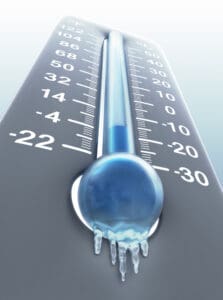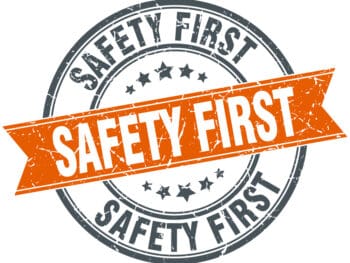
Extreme Cold Affects Individuals in Three Ways
- Air temperature
- Wind speed or air movement-the wind chill temperature is what exposed flesh would feel from the combined effect of cold air and wind seed
- Wetness or humidity-water conducts heat away from the body faster than dry air
Possible Effects of Extreme Cold
- Frostbite is where the skin and tissue are damaged due to freezing. Frostbite usually occurs in exposed body parts and those farthest from the heart. Initial symptoms are itching and pain followed by the skin forming white, red, and yellow patches and becoming numb. Skin blisters may form one or two days after becoming frozen that may become hard and blackened. Deep frostbite has purplish, blood-filled blisters that turn black. Nerve damage can result in a loss of feeling. Extreme frostbite may result in fingers and toes having to be amputated. If a person is using beta-blockers, has diabetes or peripheral neuropathy they are at increased risk of frostbite.
- Hypothermia is where the body’s core temperature drops below what is required for normal metabolism, and body functions, about 95° F. Symptoms include shivering, mental confusion, and muscle incoordination, such as slow and labored movements, including stumbling. The person may be confused, although they appear alert and may have difficulty speaking and thinking. Below 86° F, the exposed skin gets blue and puffy, muscle coordination becomes very poor and the person’s behavior may be incoherent or irrational. Alcohol consumption increases the risk of hypothermia.
- Chilblains are superficial ulcers of the skin that happen with repeated cold exposure.
- Trench foot or immersion foot happens from repetitive exposure to water, at non-freezing temperatures.
Proper Safety Planning
Extreme cold temperatures cause work-related injuries that can be avoided with proper advanced safety planning and worker training. Ensure that your safety plan addresses these issues before an injury. Safety meetings should address emergency procedures such as first aid, where to get medical help, who is the designated supervisor for work injuries, and what are the symptoms of frostbite, hypothermia, and other weather-related injuries. You might want to establish a “buddy system” where workers are teamed to watch each other for these symptoms because the individual might not recognize them in themselves.
Proper Protective Clothing
Having proper protective clothing and equipment is key to avoiding injuries.
- Dress in layers-Air between layers is better insulation than a single heavy fabric. Workers can remove layers as they start to sweat or go indoors to warm up or they can add layers as they get colder. Wear a wicking layer like athletic undergarments closest to the skin to wick moisture away. Avoid cotton, which does not insulate when wet, and wool and synthetic materials. Wear a knit cap under a hard hat.
- Keep clothing clean as dirt can interfere with the insulation of some fabric fibers.
- Shoes-waterproof boots are a must in wet conditions. Consider rubber overshoes or galoshes as waterproof sprays often are not enough in extreme conditions. Shoes should have rubber bottoms and removable insoles, in case they get wet.
- Socks-keep a dry pair on hand in case the worker needs to change them if they get wet.
- Eye and face protection should not interfere with visibility and should not have metal parts touching the skin.
- Metal handles should be covered with insulating material and workers should not have to remove gloves to use. Have workers use gloves with a protective layer that can be removed to be fingerless for very brief periods for fine motor dexterity.
Modified Work Procedures
Sometimes you may have to modify work practices to account for extreme temperatures, especially where your employees work outside or in unheated areas. For example, you may need to develop a modified break schedule to allow workers to rest, warm up and change into dry clothing. You should make sure that there are heated warming shelters like tents, cabins or restrooms available. You should also pace work to avoid excessive sweating that could get clothing wet or cause body temperatures to drop. You also should allow new employees time to adjust to the cold and their protective clothing and equipment before giving them a full workload. If your workers need to drive during extreme weather, try to schedule their driving time during daylight hours when visibility is better. Also be aware that temperatures may vary throughout the day but are generally colder in the early morning.

Contact: mstack@reduceyourworkerscomp.com.
Workers’ Comp Roundup Blog: http://blog.reduceyourworkerscomp.com/
©2022 Amaxx LLC. All rights reserved under International Copyright Law.
Do not use this information without independent verification. All state laws vary. You should consult with your insurance broker, attorney, or qualified professional.








